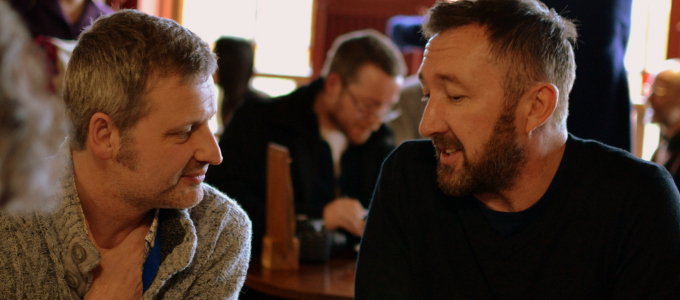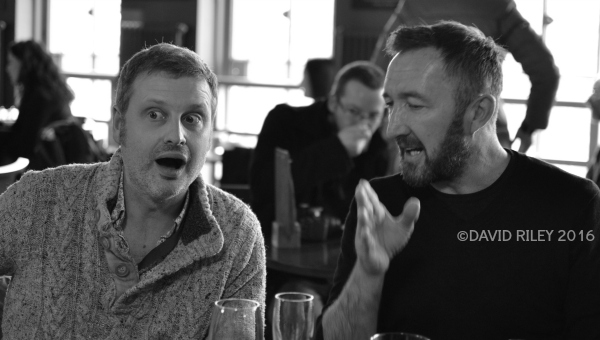
Image (C) David Riley 2016
We’re at the Arts Picturehouse in Cambridge on a cold and gloomy afternoon, and Ralph Ineson (pronounced Einnerson) has just arrived to give a Q&A for a screening of his new film, THE WITCH: a downright creepy and immersive slice of horror set in 17th century New England.
Ralph is tall and imposing, with a firm handshake. His dulcet tones are utterly distinctive and boom from somewhere deep below, akin to the call of the Bittern. He is also totally engaging and an utter gentleman, agreeing to sit with TAKE ONE for a beer and quick chat after the Q&A to talk about the film and his character William.
THE WITCH tells the story of a Puritan family, exiled from their community, who set up home on the edge of an isolated wood. Their baby is tragically taken by what they think is a wolf, but we know is not. It starts a chain reaction that puts pressure on the family relationships and their deeply held beliefs in God that lead to some startling, terrifying consequences.
“To be honest, I think it’s probably the best thing I have done and the hardest shoot I have ever had to do,” says Ralph. “To my external thanks, Robert [Eggers – the director] liked my voice from The Office and Game of Thrones, so mine was the voice he had in his head for the English rhythms he had while writing the script. So when it came to his producers and investors they kind of went, ‘well why not have Ralph do it?’. I think because they wanted to keep the audience immersed they weren’t that interested in having huge star actors playing the part. So luckily for me they went, ‘yeah let Ralph do it’”.
A low budget chiller, set in the backwoods of a cold and bleak New England winter, the shoot involved few creature comforts and a near total immersion into the world of the puritan settler of 1630. “It was a very short shoot, 26 days with weekends off, so to get a film like this shot in that time was very hard. It was hard, but you kind of wanted it to be hard: you wanted to embrace that, because life was hard for [the settlers]. Having that hardship, working those long hours, working with the goat, tracking through the forest with Caleb [his on-screen son] 50 times a day, climbing over things in those costumes was physically very exhausting. As the shoot went on it got worse and worse. I had to lose over two stone to play the part, because we were starving to death and I had to look like I was on the same diet as Kate Dickie [his on screen wife Katherine], who’s very lean. So I was very weak, and it made it very hard”.
“The dilemmas he had, it just resonated as a self-employed father with kids of a similar age…”
“Nothing in this film brings you out of this world,” he exclaims, and that is a key reason this film is so disturbing – it doesn’t let go of you. With a miniscule 3.5M budget, director Robert Eggers’ hugely assured debut creates more fear and tension than horror movies with budgets ten times the size. “Robert admitted to having a pathological attention to detail that he couldn’t let go,” says Ralph. “I mean, he found out that the circular saw was not invented for another 50 years after the film is set. So he insisted all the buildings on set had to be hand cut – can you imagine!”. The clothes are also authentic, using only traditional cloth and stitching of the age. Even the dialogue is that of the era, taken from documents and manuscripts of the time. Biblical in tone, as are all aspects of the narrative, it lets the viewer in to their world, their beliefs and fears.
There is more. The constant half-light in which the film is set creates a sense of despair and impending doom that totally unsettles the viewer. “We had to spend a lot of time waiting around to shoot any exteriors, as Jarin [Blaschke – the cinematographer] wouldn’t shoot if there were any light. It had to be complete cloud cover. Everything had to be grey just to bring that palette down. Everything was shot in candle light [except the shots with the Raven], all natural lighting, nothing artificial to take you out of that world”. It is these touches that elevate this film above the norm and allow for an utterly immersive experience, transporting the viewer into their time. You leave the cinema in stunned silence, blinking your way back to the 21st century.
The film is well cast, with Anya Taylor-Joy playing elder daughter Thomasin and Harvey Scrimshaw as the middle son Caleb, both loving and fearful of their father in equal measure. However, it is William’s wife Katherine, played by Kate Dickie, that provides the perfect balance to Ineson’s character. He is a loving father, fearful of God and with ideas that may seem strange to us now, but who just wants to do right by his family. Katherine desperately wants her children safe, as any mother would, and it is her desire for this, set against William’s inability to prevent certain events, that ratchets up the tension, like a guitar string about to snap. “Where Kate got in the grave and looked back at me, my reverse shot of it … there are a few shots in the film, when Kate is doing her thing, I didn’t have to think,” says Ineson. “Acting, sometimes it just happens, a lot of the time you have to work at it technically, sometimes it just comes. Working with Kate Dickie, it just comes. All I had to do was just look at her … And everything happens, the look that she gave me when she got in that grave just gave me a physical reaction, without me having to bring that on at all – you know”.
“As soon as I read the script I knew I was dealing with someone who really knew what he was doing”
Any father can identify with William’s position and any mother with Katherine’s. It is this that makes this film more kitchen sink drama than horror, perhaps strangely more akin to a soap. “I loved the part and it really resonated with me as a father,” says Ralph. “The dilemmas he had, it just resonated as a self-employed father with kids of a similar age – a lot of the pressure William experienced felt very real, very modern.” The disintegration of a domestic situation, the breakdown of a family are all relevant themes today, and give this film a level of pathos not usually associated with the horror genre. It may be set in the 1630’s but the family relationships feel current. There may be evil outside in the woods but this film feels less about that and more about relationships. These people believe, literally, in the physical manifestation of evil to the extent that you wonder if they create it all in their heads, and all we are really watching is a family in crisis.
Either way, this film has garnered a lot of critical respect at the film festivals and now goes on general release (March 11th). “All you can judge is your gut instinct and how good you think it’s going to be,” says Ralph. “You can never guess how successful something’s going to be, how it’s going to resonate with other people. You’ve got to trust your own judgement. As soon as I read the script and had spoken to Robert I knew I was dealing with someone who was incredibly intelligent, cogent, who really knew what he was doing”. This film really does know what it is doing and as has been said by several people already, sets the bar very high for other horror movies this year. Few will match it. An intelligent, insidious and thoughtful nugget of fear, this film will haunt you like glue.
httpvh://youtu.be/iQXmlf3Sefg

